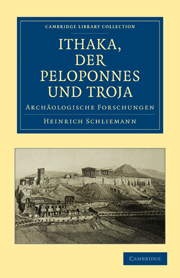Book contents
- Frontmatter
- VORREDE
- Contents
- ERSTES KAPITEL: KORFU
- ZWEITES KAPITEL: KEPHALONIA
- DRITTES KAPITEL: ITHAKA
- VIERTES KAPITEL
- FÜNFTES KAPITEL
- SECHSTES KAPITEL
- SIEBENTES KAPITEL
- ACHTES KAPITEL
- NEUNTES KAPITEL
- ZEHNTES KAPITEL
- ELFTES KAPITEL
- ZWÖLFTES KAPITEL
- DREIZEHNTES KAPITEL
- VIERZEHNTES KAPITEL
- FUNFZEHNTES KAPITEL
- SECHZEHNTES KAPITEL
- SIEBZEHNTES KAPITEL
- ACHTZEHNTES KAPITEL
- NEUNZEHNTES KAPITEL
- ZWANZIGSTES KAPITEL
- EINUNDZWANZIGSTES KAPITEL
- ZWEIUNDZWANZIGSTES KAPITEL
- Plate section
ZWEITES KAPITEL: KEPHALONIA
Published online by Cambridge University Press: 05 August 2011
- Frontmatter
- VORREDE
- Contents
- ERSTES KAPITEL: KORFU
- ZWEITES KAPITEL: KEPHALONIA
- DRITTES KAPITEL: ITHAKA
- VIERTES KAPITEL
- FÜNFTES KAPITEL
- SECHSTES KAPITEL
- SIEBENTES KAPITEL
- ACHTES KAPITEL
- NEUNTES KAPITEL
- ZEHNTES KAPITEL
- ELFTES KAPITEL
- ZWÖLFTES KAPITEL
- DREIZEHNTES KAPITEL
- VIERZEHNTES KAPITEL
- FUNFZEHNTES KAPITEL
- SECHZEHNTES KAPITEL
- SIEBZEHNTES KAPITEL
- ACHTZEHNTES KAPITEL
- NEUNZEHNTES KAPITEL
- ZWANZIGSTES KAPITEL
- EINUNDZWANZIGSTES KAPITEL
- ZWEIUNDZWANZIGSTES KAPITEL
- Plate section
Summary
Den 7. Juli am Abend fuhr ich mit dem Dampfboot der hellenischen Gesellschaft nach Argostoli, auf der Insel Kephalonia, wo ich am folgenden Tage 5½ Uhr Morgens ankam.
Am Eingang des Hafens beobaclitet man ein sehr merkwürdiges Phänomen, welches ganz gegen die Ordnung der Natur zu sein scheint: denn, während sich sonst die Flüsse vom Lande ins Meer ergiessen, ergiesst sich hier das Meer an zwei Stellen in das niedrige, ausgehöhlte Ufer in starken Strömungen, welche sich in unterirdische Gänge verlieren. Das Wasser fiiesst beständig, und mit soldier Regelmässigkeit und Gewalt, dass man über den Flüssen zwei grosse Kornmühlen erbaut hat, welche Tag und Nacht arbeiten, und deren Ertrag bedeutend ist.
Kephalonia, die grösste der ionischen Inseln, liegt am Eingang des Meerbusens von Korinth, der Küste Akarnaniensgegenüber; im Nordosten wird sie von der Insel Ithaka durch einen Kanal getrennt, dessen durchschnittliche Breite 8½ Kilometer beträgt.
Nach Strabo (X, 2) hat sie 300 Stadien im Umfang, während dieser in der That 206 Kilometer beträgt; ihre grösste Länge beläuft sich auf 53 Kilometer.
Same und Samos heisst sie bei Homer (Od. IV, 671), welcher wahrscheinlich den Namen der Hauptstadt für die ganze Insel gebraucht, denn er nennt die Einwohner Κεφαλλῆνες und Unterthanen des Odysseus (Il. II, 631).
- Type
- Chapter
- Information
- Ithaka, der Peloponnes und TrojaArchäologische Forschungen, pp. 11 - 13Publisher: Cambridge University PressPrint publication year: 2010First published in: 1869

